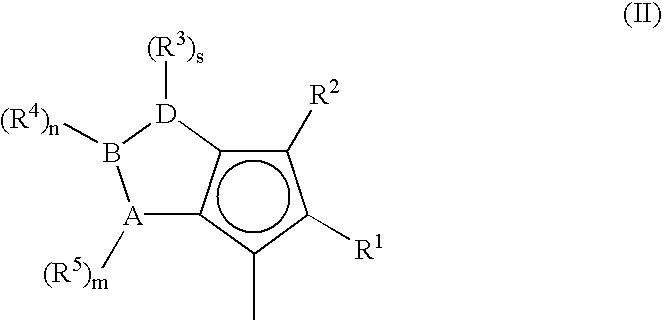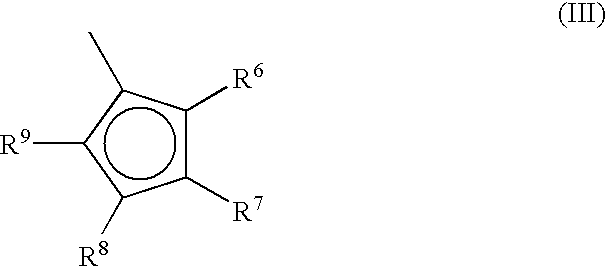Metallocene compounds, process for their preparation and their use in catalytic systems for the polymerization of olefins
- Summary
- Abstract
- Description
- Claims
- Application Information
AI Technical Summary
Benefits of technology
Problems solved by technology
Method used
Image
Examples
example 2
Synthesis of dimethylsilandiylbis-6-[2,5-dimethyl-3-(2'-methyl-phenyl)cyclopentadienyl-[1,2-b]-thiophene]zirconium dichloride-SiMe.sub.2 [Me.sub.2 (MePh)CpThiophen]ZrCl.sub.2 (see FIG. 2)
##STR20##
Synthesis of 2-Me-3-bromothiophene
A solution of 3-bromothiophene (17.4 g, 0.107 mol) in 10 mL of THF was added dropwise to lithium diisopropylamide (12.5 g, 0.110 mol) in THF (75 mL) at -78.degree. C. After completing the addition, the reaction mixture was slowly warmed to 0.degree. C. and stirred for 0.5 h. The dark solution was cooled to -78.degree. C. and treated with iodomethane (2.28 g, 0.110 mol). The temperature was raised to -10.degree. C. and stirring continued for 15 minutes. Water (100 mL) was added slowly and most of the THF was evaporated on a rotoevaporator. The product was extracted with ether (2.times.100 mL) and dried (MgSO.sub.4). Rotoevaporation of the solvent yielded 12 g of crude product (68%). The title compound was analysed by .sup.1 H-NMR spectroscopy.
Synthesis of 2-...
example 3
Synthesis of dimethylsilandiylbis-6-[3,5-dimethylcyclopentadienyl-[1,2-b]-thiophene]zirconium dichloride-SiMe.sub.2 (Me.sub.2 CpThiophen)ZrCl.sub.2
##STR21##
Synthesis of 2,5-dimethyl-6-hydrocyclopenta[1,2-b]thiophen-4-one
##STR22##
To a flask containing 950 g of 84% polyphoshopric acid (Aldrich) was added 180 g of P.sub.2 O.sub.5. The slurry was heated to 140.degree. C. for 4 h (until al P.sub.2 O.sub.5 had dissolved), then cooled to 70.degree. C. Dropwise, a solution containing 100 g (1.01 mol) 3-methylthiophene, 86 g (1 mol) methacrylic acid, and 60 ml dichioromethane was added. The mixture was refluxed for 2 h then the solution was poured onto ice. The organic layer was collected with a 30% dichloromethane / hexane solution which was washed with water, saturated bicarbonate solution, water, then dried over magnesium sulfate, filtered, then the solvents were removed in vacuo. 143 g of dark brown oil was recovered. The oil was distilled at 78.degree. C. at 500 microns; 10.2 g of pale ye...
example 4
(Comparison)
Dimethylsilandiylbis-4-(2,5-dimethyl-1-phenylcyclopentadienyl-[2,1-b]-pyrrol)zirconium dichloride-SiMe.sub.2 (Me.sub.2 PhCpPyrrol)ZrC.sub.2
This compound was prepared according to the procedure of Example 13 described in WO 98 / 22486. ##STR24##
PUM
| Property | Measurement | Unit |
|---|---|---|
| Temperature | aaaaa | aaaaa |
| Temperature | aaaaa | aaaaa |
| Temperature | aaaaa | aaaaa |
Abstract
Description
Claims
Application Information
 Login to View More
Login to View More - R&D
- Intellectual Property
- Life Sciences
- Materials
- Tech Scout
- Unparalleled Data Quality
- Higher Quality Content
- 60% Fewer Hallucinations
Browse by: Latest US Patents, China's latest patents, Technical Efficacy Thesaurus, Application Domain, Technology Topic, Popular Technical Reports.
© 2025 PatSnap. All rights reserved.Legal|Privacy policy|Modern Slavery Act Transparency Statement|Sitemap|About US| Contact US: help@patsnap.com



